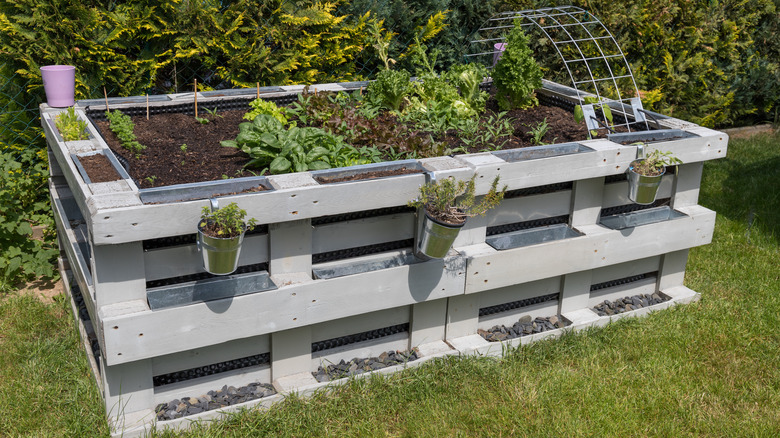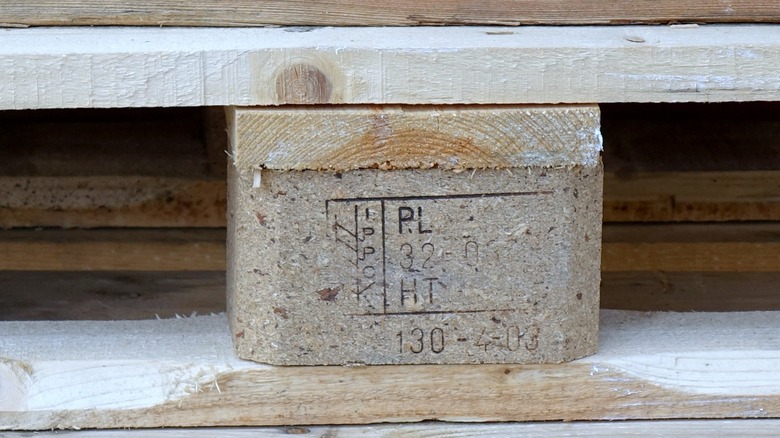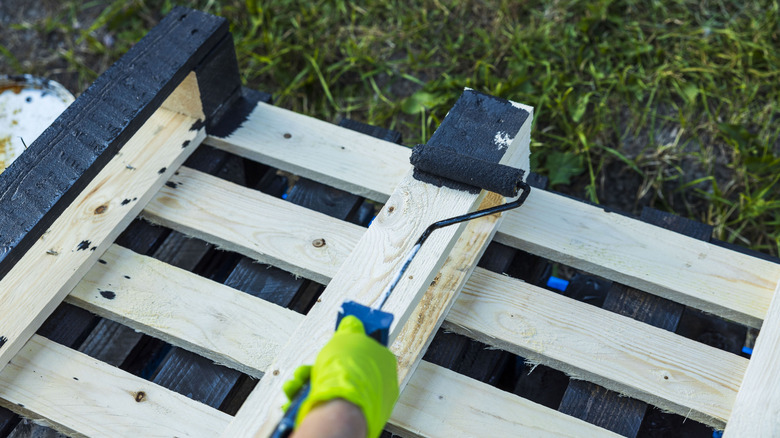Precautions To Take When Using Wooden Pallets For Your Outdoor DIYs
For upcyclers and other trash to treasure enthusiasts, wooden pallets are like diamonds in the rough. These DIY darlings are especially popular among gardeners and backyard builders. Social media platforms are teeming with creative ways you can upcycle wood pallets for your yard or garden. A plant stand? Easy-peasy. A swing? No problem. An outdoor furniture set? Sure thing. A swimming pool? Well, it depends on how much actual swimming you want to do, but yes, it's been done.
It's easy to see why pallet projects are so popular. With 2.6 billion pallets in use in the United States, your chances of scoring free or low-cost lumber are pretty good. In addition to being inexpensive and eco-friendly, pallet projects are also a low-risk entry into woodworking. But low risk doesn't mean no risk. All pallets are not created equal, and it's important to choose the correct type for your safety and the longevity of your project. Similarly, you'll need to take additional time to weatherproof your DIY pallet project unless you want to watch your hard work quickly rot away in the sun and rain. Whether you're using pallets to save money or to save the planet (or both), by taking a few precautions, you can protect yourself and ensure your projects last for years to come.
Safety precautions when working with wooden pallets
Although there are many places to find free pallets near you for your outdoor project, you'll want to select pallets free of harmful chemicals. To comply with the International Plant Protection Convention (IIPC), internationally shipped pallets must be treated to prevent the transportation of invasive insects or plant diseases. While some treatment methods are safe, others are not. Fortunately, most pallets are stamped with letters that indicate how the wood was treated. Look for pallets marked with HT for heat-treated or KD for kiln-dried. Both methods involve heating the pallets to high temperatures to kill insects and parasites. Avoid pallets stamped with MB, which indicates they were treated with methyl bromide, a toxic pesticide.
Many pallets in the U.S. are made from softwoods like pine, which are lighter but less durable. The boards on these pallets are more likely to warp, crack, or splinter. You can sometimes find hardwood pallets, usually made of oak or maple, which are more durable but also much heavier. For many outdoor projects, pine pallets are acceptable, but hardwood is a better choice for furniture. Whatever type of pallet you choose, wearing heavy gloves and eye protection is important. Pallets are often assembled using spiral shank nails, which are very tough to remove. Prying off the boards with a crowbar can be dangerous. This video from Make Magazine demonstrates how to safely break down a pallet using hand tools.
How to protect your outdoor pallet projects
Once you've selected pallets for your outdoor project, you'll need to treat the wood with paint, stain, or sealant to protect it from moisture and UV rays. Exterior-grade paint is the best option to safeguard wood exposed to direct sunlight. Outdoor wood stain is another option for preventing UV and water damage, but if you prefer a natural wood finish, you can apply a sealant. Outdoor oil finishes — like Tung oil, Danish oil, linseed, and hemp — give pallet wood a richer, radiant appearance but offer little UV protection and require reapplication every year. Marine spar varnish, used on boats, provides a natural look with water and UV protection. It's also easy to use and a good choice for woodworking newbies.
In addition to treating the wood, be sure the hardware you choose is weatherproof. Stainless steel and aluminum fasteners are a good choice, but ceramic fasteners and deck screws are also corrosion-resistant. If you use wood glue on your project, you'll want to ensure it is water-resistant. Polyvinyl acetate (PVA) glues, like Titebond III, work well for many projects. Polyurethane glues and two-part epoxies are also effective options. Whether building a simple plant stand or transforming pallets into a stunning backyard deck, by taking a few precautions, your outdoor pallet projects will stand the test of time.


